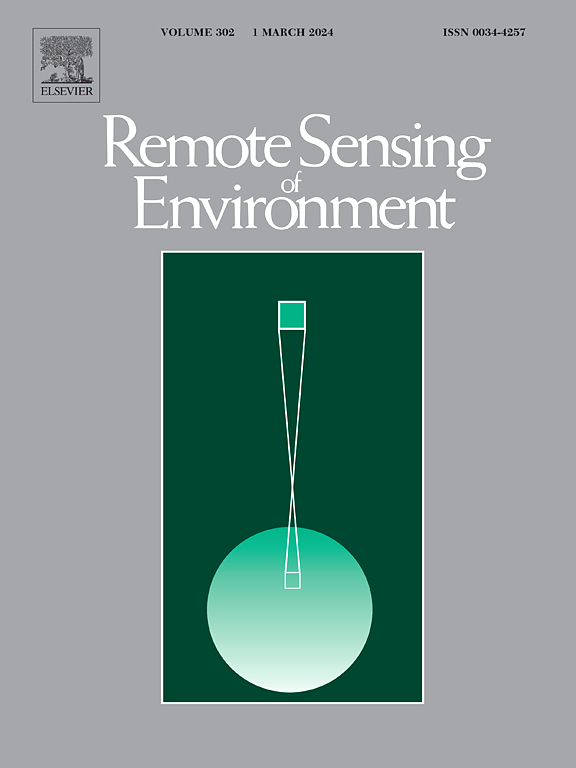SIFFI: Bayesian solar-induced fluorescence retrieval algorithm for remote sensing of vegetation
IF 11.4
1区 地球科学
Q1 ENVIRONMENTAL SCIENCES
引用次数: 0
Abstract
Remote sensing of solar-induced vegetation chlorophyll fluorescence (SIF) has a rich history of more than 50 years of research covering active and passive techniques from leaf, canopy, and satellite scale. Current satellite-derived SIF products primarily focus on the far-red spectral range, with variations in techniques dependent on sensor capabilities. However, these retrieval methods often rely on parametric spectral models and are constrained to narrow absorption regions. In this paper, we introduce a novel Bayesian retrieval technique, referred to as SIFFI (Siffi Is For Fluorescence Inference), designed for the flexible and robust estimation of spectrally resolved fluorescence spectra. SIFFI utilizes spectral representations for both fluorescence and surface reflectance, enabling its application to distinct spectral ranges, e.g., red, far-red, and full spectral range. Also, its applicability extends to top-of-canopy (TOC) and top-of-atmosphere (TOA) measurements, with the latter being possible when auxiliary information about the atmospheric state is available. For the assessment of SIFFI, we performed an extensive proof-of-concept simulation exercise involving diverse scenarios that integrated measured leaf-level fluorescence and reflectance signals, propagated them to the TOC and TOA levels, and perturbed the resultant signal with instrument Gaussian noise to simulate realistic conditions. Additionally, we extend our assessment exercise to TOC measurements acquired by a fluorescence box (FloX) instrument during two diurnal cycles on sunlit and cloudy conditions. In all the TOC cases, simulations- and measured-based scenarios, we compared our SIF estimates with the results from two well-established methods: the improved Fraunhofer line discrimination method (iFLD) and the Spectral Fitting (SpecFit) method covering the full fluorescence spectra. Notably, our results highlight the versatility and accuracy of SIFFI in estimating spectrally resolved fluorescence, achieving Mean Absolute Error (MAE) values of 0.07 (0.09) in the TOC (TOA) simulation scenarios, improving the SpecFit method estimates, and being aligned with the iFLD method results at the oxygen bands. SIFFI represents a significant advancement in SIF retrieval, providing a robust approach that exploits the full spectral information from the red to the near-infrared regions.
SIFFI:植被遥感贝叶斯太阳诱导荧光检索算法
太阳诱导的植被叶绿素荧光遥感(SIF)研究已有 50 多年的丰富历史,涵盖了从叶片、冠层到卫星尺度的主动和被动技术。目前的卫星 SIF 产品主要集中在远红外光谱范围,根据传感器能力的不同,技术也有所不同。然而,这些检索方法通常依赖于参数光谱模型,并受限于狭窄的吸收区域。在本文中,我们介绍了一种新颖的贝叶斯检索技术,即 SIFFI(Siffi Is For Fluorescence Inference),它专为灵活、稳健地估计光谱分辨荧光光谱而设计。SIFFI 利用荧光和表面反射率的光谱表示法,可应用于不同的光谱范围,如红光、远红光和全光谱范围。此外,它的适用范围还扩展到树冠顶(TOC)和大气层顶(TOA)测量,后者可在有大气状态辅助信息的情况下进行。为了对 SIFFI 进行评估,我们进行了广泛的概念验证模拟演练,其中涉及各种不同的情况,将测量到的叶片级荧光和反射信号整合在一起,传播到 TOC 和 TOA 级,并用仪器高斯噪声对由此产生的信号进行扰动,以模拟现实条件。此外,我们还将评估工作扩展到荧光盒(FloX)仪器在日照和多云条件下的两个昼夜周期中获取的 TOC 测量值。在所有的 TOC 案例、模拟和测量场景中,我们将 SIF 估计值与两种成熟方法的结果进行了比较:改进的弗劳恩霍夫线判别法(iFLD)和覆盖整个荧光光谱的光谱拟合法(SpecFit)。值得注意的是,我们的结果凸显了 SIFFI 在估算光谱分辨荧光方面的多功能性和准确性,在 TOC (TOA) 模拟场景中,其平均绝对误差 (MAE) 值为 0.07 (0.09) [mW/(m2srnm)] [mW/(m2srnm)],改善了 SpecFit 方法的估算结果,并且在氧波段与 iFLD 方法的结果一致。SIFFI 在 SIF 检索方面取得了重大进展,提供了一种利用从红外到近红外区域全部光谱信息的稳健方法。
本文章由计算机程序翻译,如有差异,请以英文原文为准。
求助全文
约1分钟内获得全文
求助全文
来源期刊

Remote Sensing of Environment
环境科学-成像科学与照相技术
CiteScore
25.10
自引率
8.90%
发文量
455
审稿时长
53 days
期刊介绍:
Remote Sensing of Environment (RSE) serves the Earth observation community by disseminating results on the theory, science, applications, and technology that contribute to advancing the field of remote sensing. With a thoroughly interdisciplinary approach, RSE encompasses terrestrial, oceanic, and atmospheric sensing.
The journal emphasizes biophysical and quantitative approaches to remote sensing at local to global scales, covering a diverse range of applications and techniques.
RSE serves as a vital platform for the exchange of knowledge and advancements in the dynamic field of remote sensing.
 求助内容:
求助内容: 应助结果提醒方式:
应助结果提醒方式:


